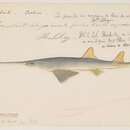Lifespan, longevity, and ageing
provided by AnAge articles
Maximum longevity: 30 years (wild)
- license
- cc-by-3.0
- copyright
- Joao Pedro de Magalhaes
- editor
- de Magalhaes, J. P.
Diagnostic Description
provided by Fishbase
Fewer sawteeth (normally 19, rarely 20 on a side). First dorsal fin originate in advance of the origin of the pelvic fins and much more deeply concave posterior margins of the dorsal fins. Saltwater species when fresh-caught, either dark gray or golden brown, while freshwater species are mouse gray with reddish along midback posterior to first dorsal fin, reddish posterior to lower part of sides, first dorsal pale yellow with reddish free rear corner; second dorsal, pelvic fins, caudal and lower sides posterior to first dorsal dull brick red. Reddish tint either normal or result of suffusion with blood below the skin (Ref. 6902).
- Recorder
- Arlene G. Sampang-Reyes
Life Cycle
provided by Fishbase
Ovoviviparous, embryos feed solely on yolk (Ref. 50449).
Migration
provided by Fishbase
Amphidromous. Refers to fishes that regularly migrate between freshwater and the sea (in both directions), but not for the purpose of breeding, as in anadromous and catadromous species. Sub-division of diadromous. Migrations should be cyclical and predictable and cover more than 100 km.Characteristic elements in amphidromy are: reproduction in fresh water, passage to sea by newly hatched larvae, a period of feeding and growing at sea usually a few months long, return to fresh water of well-grown juveniles, a further period of feeding and growing in fresh water, followed by reproduction there (Ref. 82692).
Biology
provided by Fishbase
Inhabits shallow water in the vicinity of the shore and estuarine, particularly lagoons. Generally thought to rarely descend below 10m but have been found at 122m in Lake Nicaragua (Ref. 55273). Tends to run farther upstream in large rivers. Found in temperatures higher than 20-30°C (Ref. 6902). Ovoviviparous (Ref. 50449). Minor commercial, for the curio trade (Ref. 37548).
Importance
provided by Fishbase
fisheries: minor commercial; price category: medium; price reliability: very questionable: based on ex-vessel price for species in this family

